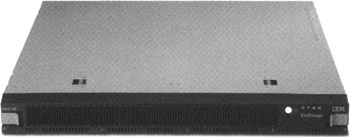IBM TotalStorage
|
In the past, storage devices by themselves were considered to be just another part needed to build a server. Rarely was storage thought of as an independent and strategic tool for business. Today in the e-business world, that has changed. e-business is the driving force behind an ever-increasing demand for more storage at a lower cost with higher levels of availability to gain strategic competitive advantage. The trend in storage technology is moving away from the traditional storage devices attached directly to servers in favor of independent storage devices that attach directly to a network. Since the proliferation of storage devices also makes it increasingly difficult to manage storage, specialized storage management software is also becoming more and more strategic to e-business infrastructures.
In IBM terms, hardware items like disk storage systems, tape libraries, and optical drives fall under the IBM TotalStorage brand. Disk storage devices range from small disk drives to complete storage systems like the Enterprise Storage Server that offers up to 55.9 TB of disk storage. Most of the disk storage devices attach directly to networks (called network-attached storage) like the rack-mounted NAS 100 shown in Figure 2.7.

Figure 2.7: The IBM TotalStorage NAS 100 is a network-attached storage device.
As for tape devices, there is everything from a simple tape drive to the Enterprise Tape Library, which can manage up to 6,240 tape cartridges full of information. TotalStorage optical storage includes everything from a simple CD-ROM drive to the 3995 Optical Library, which can store 2.682 TB on optical media. There is also specialized software used to manage storage devices and the information they contain.
Storage devices hold the information that is the life blood of any business. This information must be made readily available to users of various servers running various operating systems. This is necessary to perform the integration of core business processes and gain competitive advantage through e-business. Clearly, the same discussions of reliability, autonomic principles, virtualization, performance, integration, open standards, etc., that surround server selection are equally important when you select the storage devices you will use to build your e-business infrastructure.
To see an example of how storage is critical to an e-business infrastructure, consider what happened at Whirlpool Corporation, headquartered in Benton Harbor, Michigan. Whirlpool, a large manufacturer of home appliances, once had a far-flung computing infrastructure with local data centers scattered around the world—each with its own servers, storage devices, application programs, networking, etc. To reduce costs and improve operations, Whirlpool consolidated the local data centers and put all corporate users on one global network. Some older in-house application programs were retired in favor of key enterprise software suites, including SAP (enterprise resource planning functions) and Siebel (supporting their customer call centers and field service operations). As part of the project, most of Whirlpool's transaction processing was consolidated into one large data center located in Benton Harbor, using four large mainframe servers and over 500 stand-alone UNIX (including pSeries) and Windows NT servers.
These changes resulted in significant annual savings in networking and data center costs, but Whirlpool had yet to achieve the full benefits from its consolidation efforts. They had not upgraded their aging storage infrastructure, and the response times for their SAP real-time order processing were slowing. The process of backing up the information on their old storage devices to their tape library servers was causing bottlenecks. Their overnight batch-processing window was expanding and was getting closer to interfering with daily "live" operations. In short, the storage component of their infrastructure was not up to the task.
Whirlpool solved its storage problems by moving off its slow storage devices. On the mainframe side, they migrated their information from RAMAC Virtual Arrays to three large IBM TotalStorage Enterprise Storage Servers (called Sharks). As a result, increases in batch processing throughput ranged from 40% to 80%, and Whirlpool had their batch-processing window back under control. The upgrade to Sharks also improved response time for the SAP users by 21% in its European operations and 25% in North America. To support the many UNIX and NT servers, Whirlpool moved away from direct-attached storage devices and implemented storage area networks, giving them the flexibility to allocate and re-allocate storage as the server needs change. According to Jim Haney, Whirlpool's VP of architecture, "Instead of giving everybody only 30% or 40% of the free disk space on a server and wasting the rest, we'll be able to optimize utilization across the storage complex." Over time, Whirlpool intends to support both mainframe and UNIX/NT servers with storage area networks and share the same storage and tape backup devices for both.
-
Info on IBM TotalStorage
-
Several papers on storage technology (IBM Research)
-
More on Whirlpool's e-business projects
|
EAN: 2147483647
Pages: 56